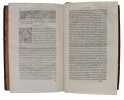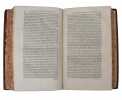"DIONYSSOS HALICARNASSOS - DIONYSIUS of HALICARNASSUS.
Romaikes Archaiologias Biblia Deka (in Greek). Antiquitatum Romanarum. Lib. X. Ex Bibliotheka Regia. + Peri Syntheseos Onomaton pros Roufon (in Greek). De compositione, seu orationis partium apta inter se collectione, ad Rufum. - [THE MAGNIFICENT EDITIO PRINCEPS OF THE MOST IMPORTANT SOURCE TO OUR KNOWLEDGE OF ROMAN HISTORY]
Paris, Robertus Stephanus, 1546 + 1547. Folio. Early 17th century full calf binding with six raised bands to spine, gilt title-label and single line-gilding to both spine and boards. Red speckled edges. Leather on boards with abrasions, and spine and corners restored. Loss of the original leather to capitals. First and last leaves with a bit of light brownspotting, but otherwise just the slightest of brownspotting. A very good, clean, well-margined copy. 19th century owner's name (Aubert) to inside of front board, 18th century note to front free end-paper, and Abraham du Prat's (1616-1660) handwritten ex-libirs to the first title-page, above which he has noted R. Estienne's age and year of death. Early armorial and Lyon Public College stamp (19th century) to blank part of first title-page. 538 (recte 542), (2) pp. + 128, (4) pp. Magnificently printed in Greek lettering, in Garamond's Grecs du Roi type, with titles, corrections, and colophons in Latin. Large decorated woodcut ornaments and initials. Title-pages with woodcut snake and olive branch.
Reference : 60337
The splendid first edition - with a highly interesting provenance - of Dionyssos Halicarnassos' extremely important ""Roman Antiquities"", also known as ""Early Roman History"", which, together with Livy’s, is the most valuable source to our knowledge of early Roman history. It treats of Rome from its origins to the First Punic War, in twenty books, of which only the first 11 remain extant. Dionysius is the first major historian of early Roman history whose work is now extant, and his seminal “Roman Antiquities” is responsible for most of the knowledge that we have of ancient Rome as well as the primary source for the accounts of the Roman foundation myths, including that of Romulus and Remus. The myth spans the first 2 volumes of the work, beginning with Book I chapter 73 and concluding in Book II chapter 56. Most other ancient historians who wrote about early Roman history almost certainly used Dionysius as a source for their material, which can be traced back to the foundational magnum opus “Roman Antiquities”. Though written from a pro-Roman standpoint, the work was very carefully researched. Dionyssos selected carefully among authorities and preserved a wealth of details that would otherwise not have been known to us today. This seminal editio princeps is of the utmost importance for obvious historic reasons, but also plays a significant role in printing history. It is usually referred to as one of the most beautiful Greek books ever printed (beginning with Harwood), and it is with this edition that Robert Estienne’s son Henri, then merely 15 years old “was introduced to the work of his life, by helping his father correct the text. The book, magnificently printed in “grecs du roi”, has been called (by Harwood) one of the most beautiful Greek books ever printed. It is said that Francois I himself selected the work for publication from a manuscript in his library.” (Schreiber). “EDITIO PRINCEPS. “One of the most beautiful books the Greek press ever produced”, says Harwood. Freytag, in his Adpar.litt.t.ii. 1304-13, treats largely of this splendid edition, and of the books it contains (note: Besides the eleven books of Roman antiquities, it contains the first four chapters of “Ars rhetorica, de Genere dicendi Thukydides,” &c). “Typis vereregiis ac nitidissimis” says Fabricius.” (Dibdin). As often, the present copy of the “Roman Antiquities” is bound with Dionyssos’ rhetorical works “De compositione” etc., described as Schreiber as “Beautiful edition of Dionysius’ rhetorical works, which Robert printed, in “grecs du roi,” as a companion volume to the precious item (i.e. “Roman Antiquities”"" the two works are often found together. Provenance: Abraham du Prat (1616-1660) was a famous French physician and prominent member of l'Académie Montmor, a group of scholars who met in Paris to discuss scientific questions. He corresponded with Hobbes and translated Caspar Bartholin's ""Anatomicae institutiones"". Dibdin: I:507" Schreiber: 91a & 91b Renuard: 68:24 Adams D:626. Brunet II:726.
Bookseller's contact details
Herman H. J. Lynge & Son
William Schneider
Silkegade 11
1113 Copenhagen
Denmark
+45 33 155 335
Payment mode
Sale conditions
All items may be returned for a full refund for any reason within 14 days of receipt.
 Write to the booksellers
Write to the booksellers







